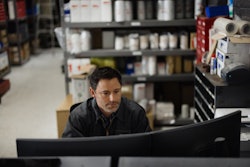To view a pdf of this article with the graphs, click here.
Even many of the most frugal forecasters and dire predictors did not expect the trucking industry to fare as badly as it did in 2007. A cliff event for new truck/trailer sales and OEM truck/trailer build was expected after the 2006 pre-buy in advance of stricter emissions regulations.
Though final 2007 economic figures were not yet available as of press time, the cliff will be steeper and deeper than what many expected. New Class 8 truck sales are predicted to be down about 45 percent from 2006. OEM production will be down even more.
The reasons are largely a soft general economy and the housing market crisis, which have weakened freight tonnage by approximately 1-1⁄2 to 2 percent versus last year. Add to this the record number of trucks produced in 2006, and many carriers have more capacity than loads, resulting in trucks sitting idle in fleet yards or unsold on dealership lots.
The aftermarket was spared from the full brunt of these forces in 2007. While most distributors report business as far from robust, it generally was stable. A stronger first-half helped balance out weaker second-half performance as the economic troubles made their way into the parts and service sector.
“The landscape of the market in 2007 went from somewhat weak to weaker,” says Tom Stewart, president of Carolina Rim and Wheel. “The first six months, at least for our business, held about even with 2006. But through the second six months we’ve definitely seen a slowdown, and it doesn’t look like it’s going to get a whole lot better for 2008 until we see housing start to come back. And I think that’s going to take a while, especially with the mortgage situation.”
Adds Vince Mathews, owner, Capitol Clutch & Brake, “Generally the dynamics that affected the nation had an impact on the truck parts market. The loan default crisis, along with the accompanying drop in housing starts, was a huge factor. Fewer homes mean fewer new shopping centers, roadways, material hauling, concrete and every other service that is related to construction.”
Tim Kraus, president and chief operating officer of the Heavy Duty Manufacturers Association (HDMA) puts the impact of the housing crisis further into perspective.
“The current housing slump alone accounts for a loss of nearly eight million truckloads of freight hauled in the past four quarters,” Kraus says. “That sounds like hyperbole, but think about it; everything used in building a house – every nail, board, wire, appliance and household move-in goods – all come by truck.”
Simply put, trucks that aren’t moving don’t need replacement parts or service work. In fact, they may even take business away from parts distributors.
“With the glut of new trucks coupled with the reduction in utilization, the result is very negative for the aftermarket,” says Marc Karon, president of Total Truck Parts. “We have seen fleets parking trucks and using those trucks for parts for the operating trucks. This has helped to hold down sales.”
ALL IN ALL
But all things considered, 2007 was not a bad year economically for the aftermarket. Suppliers report aftermarket demand was steady, and some even report modest growth.
“I think when you look at the aftermarket, it’s been an interesting year,” says Joe McAleese, president and CEO of Bendix Commercial Vehicle Systems. “The general economy and the tonnage indicate the market should be a little weaker than it is, but actually the aftermarket has held up much better than I would have thought given those other economic factors. Actually, the aftermarket is up slightly over last year and last year was a pretty good year.”
Baine Adams, vice president of global sales and marketing, Hendrickson, says the first half of 2007 was healthy, driven by sales of vocational, export and military products, but the company experienced slower activity in the second half. However, as a whole, he notes, “we will have a reasonably good year.
“The 2006 pre-buy spilled over into the first quarter of 2007 for most OEMs,” says Adams. “The majority of the large fleets did pre-buy and are ‘good’ for the balance of 2007 and into 2008. Add in the general economy here in the U.S. and you can see why our industry is slower than expected.”
But the pre-buy event eventually may reveal a silver lining for the aftermarket. Dave Plaster, Eaton Corporation’s global marketing manager for aftermarket, says, “A heavy pre-buy in ’06 also negatively affected the aftermarket. Because the equipment is still fairly young, the vehicles are not immediately requiring new parts. But they eventually will, and we’ll be ready with the people and products to meet the need as soon as it does arrive.”
Another result, he adds, is that customers will be running their equipment longer, requiring more replacement parts down the road.
New truck owners almost invariably use OEM dealers for their parts and service business while trucks still are under warranty. After the warranty expires, however, they turn to the independents. With the many new trucks put into service after the pre-buy, these units eventually will lead to more parts sales and service work for distributors and garages.
“The truck build in ’06 unquestionably led to more vehicles being serviced at the truck dealers under warranty in ’07,” says Mathews. “However, with the recent emission controls, I feel that some of the trucks that were purchased before the new emission standards will be run longer, which ultimately will lead to more service parts requirements.
“The aftermarket should benefit in 2009 and onward.”
With truck sales down, competition for aftermarket business increases. Fighting to offset the slump, OEM dealers often attack parts and service sales with greater zeal.
“The slowdown in new truck sales encouraged many dealers to look for other sources of revenue to make up for lost revenue,” says Karon. “This increased competition and lowered margins.”
TIGHTENING THE BELT
Reduced tonnage means carriers look even harder for ways to stay competitive. For those who perform maintenance in-house, they look to the aftermarket to discover any available cost advantages through outsourcing. The investment in carrying parts inventory and looking for hard-to-find technicians are expenses many fleets are willing to forgo during lean times.
“Parts demand was fairly consistent in ’07; what was noticeably different from prior years is that fleets and repair shops reduced the inventory they wanted to carry,” says Mathews. “They want ‘J.I.T.’ [just in time] parts supply instead of having to stock the items.”
The majority of large fleets will continue to retain the bulk of their service work, but some in the industry say the opportunity for the aftermarket to gain some of this business is growing.
“I see a large demand for outsourcing of maintenance,” says John Bzeta, owner of Fleet Brake. “Fleets are having trouble keeping up with rapidly changing technology and attracting qualified technicians. This trend will continue and develop larger jobber repair facilities.”
The demand is so great, Bzeta says, “we could fill two more buildings, but finding people [service technicians] is the bigger challenge.”
Adds Pat Biermann, president of Heavy Duty America, “In 2007 we found more fleets asking for third-party service providers for their use along with national or regional parts purchasing programs. Demand is there, but finding qualified people has slowed the process for those who wish to fill the void.”
WORKING SMARTER
Just as fleets look for innovative ways to increase efficiencies and profitability, so do distributors. As Stewart points out, many distributors’ costs continue to rise but product margins only can absorb so much while still staying price competitive. He cites fuel as one example of an upward-spiraling cost that continues to negatively impact the bottom line.
“It’s an expense we really have no control over,” he says. “It certainly impacts a business like ours when you’ve watched your fuel usage go from $6000 or $7000 a month to $20,000 a month in the last few years.”
The impact of rising costs takes an even greater toll during a period of slow market growth. The best way to survive, he says, is to “work smarter. If you’re not working smart, you’re going to get into trouble quickly.”
Implementing new business tools and technologies is one survival strategy.
“Technology is growing in importance and will leave some distributors and dealers behind,” Karon says. “Anything a company can do to positively differentiate itself will enhance its market position. EDI (electronic data interchange), bar coding and Internet parts order entry all can save money for the distributor and save money for its fleet customers.”
John Flad, Bendix Commercial Vehicle Systems’ vice president of aftermarket sales, says distributors need to keep focused on their strengths and continue to invest in their businesses, regardless of market conditions.
“I think they need to concentrate on the right portions of their business, such as adopting vendor managed inventory (VMI). They have to step up and finance their future, particularly on the technical side, so they can compete,” he says. “They have to compete with large, well-funded dealer organizations that have technology systems from their parent nameplates.
“If the independent distributor wants to compete, he’s got to finance that. I think some of the marketing groups are bringing some good programs to the table to help support their membership in this area, but they’ve got to be willing to invest,” he continues. “If they think what they’ve been doing the past five years will get them through the next five years, they may very well be wrong.”
And, when it comes to survival strategies, looking at the big picture also helps.
“Last year was the last of a string of good years,” says Stewart. “It was relatively strong and we had three or four years of good, solid growth. Truck builds were up, tonnage was moving – life was pretty good. But there have to be corrections every once in a while. This is a cyclical business; it always has been.”





